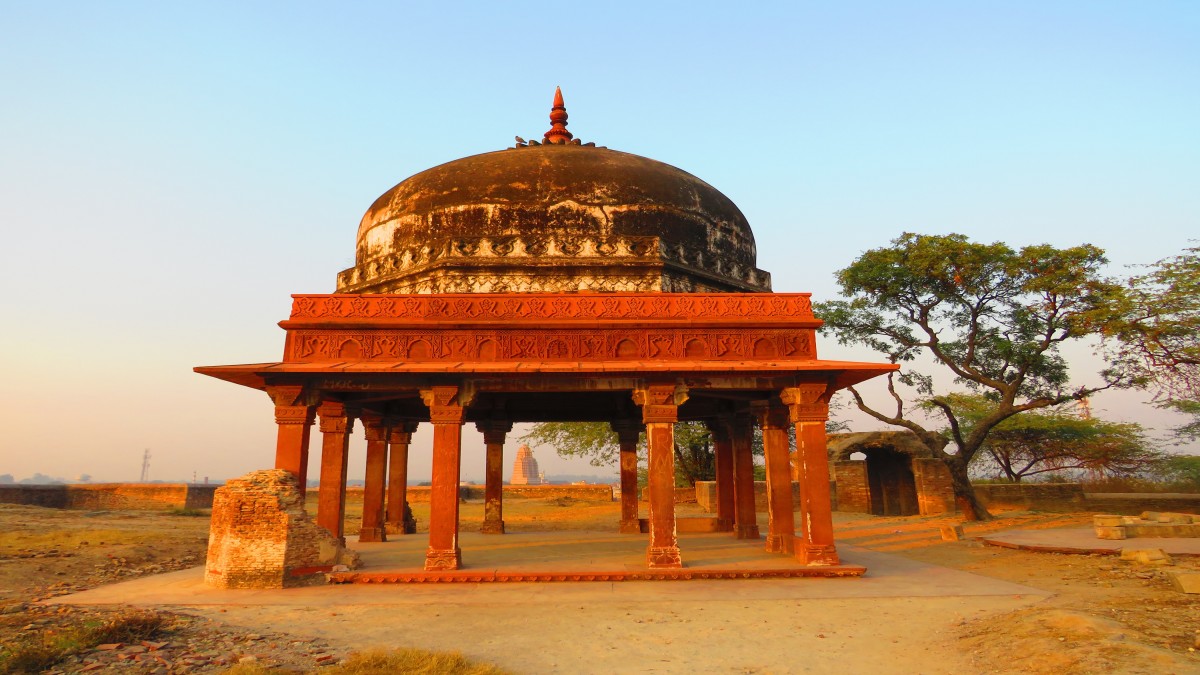The Archaeological Survey of India (ASI) list for Meerut circle has a rather innocuous item listed at third place, one which reads ‘Mound known as Lakha Mandap’, in Baghpat district of Uttar Pradesh. Chances are that most people would never have heard of the site. Fewer still would have seen the place, with visitors there being largely confined to those interested in either archaeology or mythology, or both. However, in the coming weeks, months and possibly, years, it is entirely likely that the name of this place will become well known.
I was exploring the built and cultural heritage of the western Uttar Pradesh region when I came upon this hitherto innocuous item of the ASI list and an innate curiosity took me to the spot. Having earlier walked through the excavated site at Hastinapur, in the neighbouring district of Meerut, the connection seemed obvious.
From a distance, the site at Barnawa looks like a hill. A hill surrounded by verdant fields in what is one of the country’s most productive agricultural regions. A solitary hill in a setting where there are no similar hills around. In a region where the Hindon and Krishni rivers come together. A hill dotted with groves of trees in various spots. On one side of the hill is an ASI building, marked by a board in front. A path leads on one side towards what looks like a medieval chhatri. This part is said to have housed the tomb of a Sufi called Badruddin Shah, as part of a larger graveyard. As of now, there is no sign of the gravestone.
On the other side of the ASI building, a path leads downwards from the hill. At the time of my visit, nothing on this path marked the potential significance of the place and a visitor is left to ask the guards what lies at the end of the walk. A visitor is advised to carry a stout stick to ward off monkeys. The path changes into a flight of steps which go down the hill. At this point, a person finds oneself looking into a strange hole in the hill’s side, held together by brickwork all around. The narrow hole would need an adult to crawl into it and entering an unknown dark space is hardly appealing, at the best of times.
Impact Shorts
More ShortsBut to understand Barnawa, one needs to probe beyond what is visible to the naked eye. The Barnawa ‘hill’ is actually a mound, a site ripe for archaeological excavation. As per some accounts, it was formerly ‘Varanavat’ of the Mahabharat – a place where Duryodhana had a palace of lac constructed to do away with the Pandavas. Later, it was one of the five villages asked for by Krishna from the Kauravas for their cousins.
For a historian or an archaeologist, the Barnawa mound is rich for exploration. In 2017, the ASI began some excavation at the mound. They were perhaps excited by the findings of the dig at Sinauli, also in Baghpat district, where a 4000-year old chariot had been unearthed along with various other remains that included buried bodies, swords, shields, mirrors, combs, beads and more items. In addition, in 2014, a copper crown, along with carnelian beads, was found by an amateur archaeologist at Chandayan village, a mere 6 kms from Barnawa. All this indicated the presence of an advanced civilization in the region and thus, high interest in the Barnawa mound was natural.
While excavation at the site began in April 2018, and details are awaited, the place hit the headlines recently for another matter. The site has apparently been long been of religious relevance to the local Hindu community. Around 1960 a priest named Krishnadutt Maharaj established a gurukul and ashram at the site. A decade later, in 1970, Mukim Khan, caretaker of the graveyard on the hill initiated legal proceedings to assert ownership over the land, to prevent Hindus from entering the site and performing activities such as havans.
He was challenged by the priest, who became the defendant in the case. As per the lawyer representing the Hindus, the opposing claim - that the Sufi shrine was 600 years old and that the area had been designated as waqf property by the ruler of the area at the time - were contentious as they were unable to even name the ruler.
To strengthen their argument, the defendants produced the Official Gazette of the area, dated December 12, 1920, which too failed to provide the ruler’s name. Government records also did not mention the graveyard. While the priest passed away in 1992, it was only on February 6th 2024, that the Baghpat court upheld the Hindu claim and handed over control of 100 bighas of land to them. It is entirely possible that we have not heard the last of this matter.
Regardless of the dispute, what is critical is the antiquity of the mound itself. The excavation done in 2018 apparently threw up some elements bearing a strong cultural resemblance to objects found at excavated sites in Hastinapur, Indraprastha (inside the Purana Qila in Delhi) and Kurukshetra. One hopes that a full excavation can be done in the near future and its report made public. If similar to Sinauli, it could add new dimensions to Indian History. Watch this space for more!
The author is a heritage explorer by inclination with a penchant for seeking obscure sites. A brand consultant by profession, he tweets @HiddenHeritage. Views expressed in the above piece are personal and solely that of the author. They do not necessarily reflect Firstpost’s views.
)